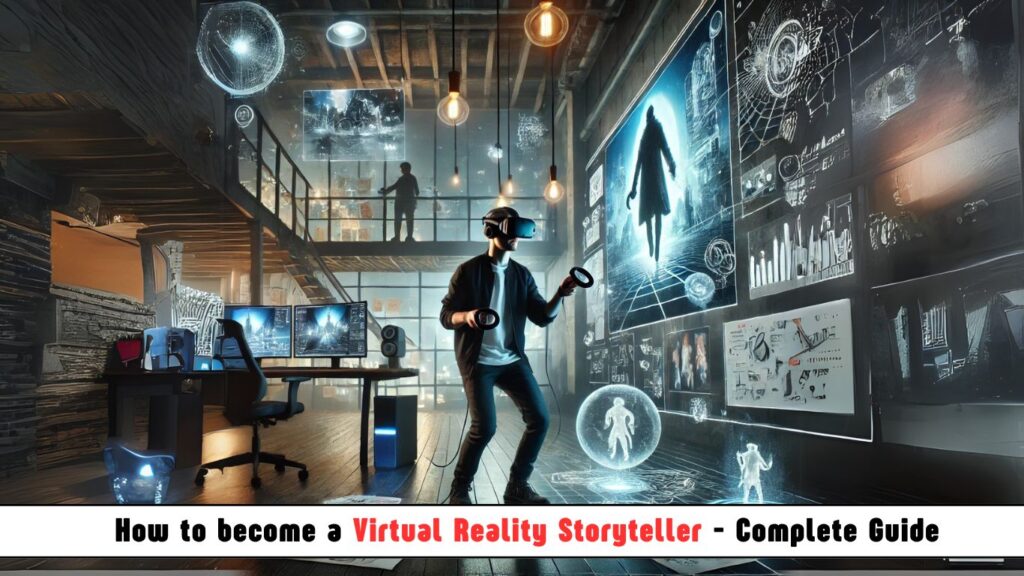
Introduction: The Dawn of Immersive Storytelling
Imagine stepping inside your favorite story – walking through Hogwarts’ halls, fighting alongside Marvel heroes, or exploring alien worlds. This is the power of Virtual Reality Storytelling, where narratives break the fourth wall to create deeply personal experiences. As VR technology advances, a new creative career emerges: the VR Storyteller, part filmmaker, part game designer, and part tech wizard.
This comprehensive guide explores everything you need to know about this cutting-edge profession, from its experimental beginnings to today’s six-figure opportunities in entertainment, education, and enterprise VR.
1. What is a Virtual Reality Storyteller?
A VR Storyteller crafts narratives specifically for immersive 360° environments. Unlike traditional media:
- You’re inside the story – Environments respond to your presence
- Branching narratives adapt to viewer choices
- Multi-sensory elements (haptics, spatial audio) enhance immersion
These professionals work across:
- Entertainment (VR films, games)
- Education (Historical recreations)
- Marketing (Brand experiences)
- Therapy (PTSD treatment narratives)
2. The Evolution of VR Storytelling
Early Experiments (1960s-1990s)
- 1962: Sensorama (first multi-sensory cinema)
- 1986: NASA’s VIEW system (early VR training)
- 1991: Virtuality arcades (first commercial VR)
The Wilderness Years (2000-2012)
Limited by clunky tech, but saw:
- Machinima experiments
- Second Life narrative communities
Modern Renaissance (2012-Present)
- 2012: Oculus Kickstarter revives industry
- 2016: “Henry” (first VR Oscar winner)
- 2020: “Half-Life: Alyx” redefines interactive storytelling
- 2023: Apple Vision Pro brings spatial computing mainstream
3. Key Roles & Responsibilities
Narrative Architect
- Designs story structures that work in 360°
- Creates “attention maps” for viewer focus
Environmental Storyteller
- Uses virtual spaces to convey plot (e.g., abandoned objects hinting at backstory)
Interaction Designer
- Implements meaningful user choices
- Balances agency vs. narrative coherence
Immersion Specialist
- Integrates haptic feedback, scent systems
- Optimizes comfort (prevents motion sickness)
Tools Used:
- Unity/Unreal Engine
- Quill, Tilt Brush
- Adobe Aero
- Spatial audio tools
4. Salary Landscape (2024)
| Experience Level | USA | UK | India | Germany |
|---|---|---|---|---|
| Entry-Level | $60k | £35k | ₹6L | €45k |
| Mid-Career | $90k | £55k | ₹12L | €65k |
| Senior | $130k+ | £80k+ | ₹25L+ | €90k+ |
Top Paying Sectors:
- Defense simulations ($140k+)
- Medical training VR
- AAA game studios
- Theme park experiences
Freelance rates: $50-$250/hour for specialized skills
5. Required Skills & Education
Essential Technical Skills:
- 3D storytelling principles
- Basic C#/Blueprints programming
- Spatial audio design
- UX for VR interfaces
Creative Competencies:
- Transmedia thinking
- Environmental narrative design
- Emotional pacing in VR
Educational Paths:
- Formal Degrees:
- USC’s MFA in VR Storytelling
- NFTS VR Director program (UK)
- Online Certifications:
- Unity VR Development Nanodegree
- Coursera’s XR Specialization
- Self-Taught Route:
- Master Unreal Engine’s VR templates
- Build portfolio pieces in ShapesXR
6. Launching Your Career
Step 1: Build Core Literacy
- Study classics like “The VR Book” by Jason Jerald
- Analyze award-winning VR narratives (e.g., “The Line”)
Step 2: Create Mini-Projects
- 30-second interactive stories in Unity
- 360° photo narratives using Insta360
Step 3: Network Strategically
- Join the VR Storytelling Alliance
- Attend Sundance New Frontier
Entry Points:
- VR production assistant
- Narrative QA tester
- Museum experience designer
7. The Future of VR Storytelling
Emerging Opportunities:
- Neuro-VR: Brainwave-responsive stories
- Volumetric Capture: Real actors in virtual spaces
- Persistent Worlds: Never-ending narratives
Disruptive Technologies:
- Apple Vision Pro’s eye-tracking narratives
- GPT-4 generated dynamic dialogue
- Haptic suits for emotional storytelling
Growth Sectors:
- Corporate training simulations
- VR psychotherapy
- Virtual tourism
Conclusion: Your Story Starts Now
VR storytelling sits at the intersection of art and technology, offering unparalleled creative freedom. As spatial computing becomes mainstream, skilled storytellers who understand immersion will lead this narrative revolution.
Next Steps:
- Experiment with free VR creation tools
- Join AltspaceVR storytelling events
- Prototype a 2-minute interactive story
The future of storytelling isn’t on screens—it’s all around us. Will you help shape it?













Post Comment